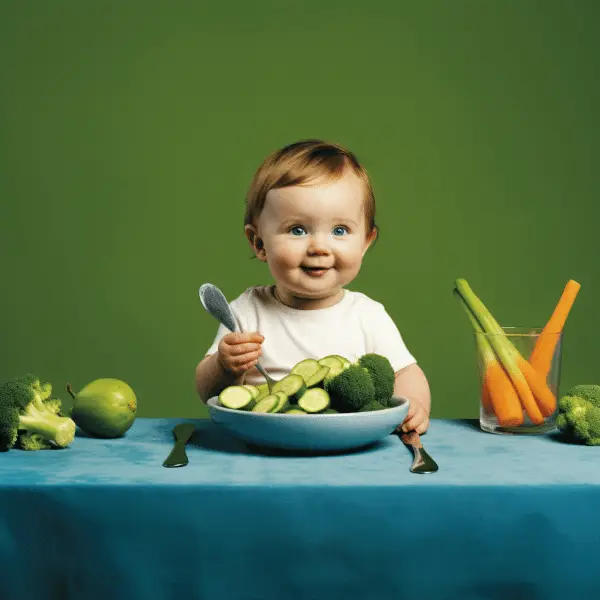Introducing Solids: Nurturing Healthy Eating Habits
Introducing solid foods is an exciting milestone in a baby’s first year. It marks the beginning of a new chapter in their nutritional journey, as they explore and experiment with different tastes and textures. But when it comes to introducing solids, it’s important to have a step-by-step guide to ensure a smooth transition and promote healthy eating habits. In this article, I will provide you with all the information you need to know about introducing solids to your baby.
Key Takeaways:
- Starting solids between 4 and 6 months is recommended, but wait for signs of readiness.
- Look for signs of readiness, such as good head control and an interest in table foods.
- There are different approaches to introducing solid foods, including purees and baby-led weaning.
- Model healthy eating habits and create a positive feeding environment to encourage your baby to explore and enjoy new foods.
- Breast milk or formula should still be the primary source of nutrition for babies until the age of one.
When to Start Introducing Solids
Introducing solid foods is crucial for your baby’s development, but determining the right time is key. Most babies are ready between 4 and 6 months, with a preference for closer to 6 months. Starting too early can strain the digestive system and contribute to childhood obesity, while delaying may lead to resistance and difficulty transitioning from milk.
To gauge readiness, observe signs like sitting with support, interest in food, and good head control. These indicators suggest your baby’s digestive system is prepared for solids, and they are developmentally ready to explore new tastes and textures.
It’s important to remember that every baby is different, and there is no one-size-fits-all answer. Consult with your pediatrician to determine the best time to start solids for your baby. They can provide guidance based on your baby’s individual needs and development.
When to Start Introducing Solids:
| Signs of Readiness | Action |
|---|---|
| Able to sit up with support | Indicates improved head and neck control |
| Showing an interest in food | Reaches for food, watches others eat |
| Good head control | Can hold their head steady |
“Starting solids is a big milestone for both baby and parents. It’s important to follow your baby’s cues and introduce solids when they are ready. Remember to consult with your healthcare provider for personalized advice.” – Dr. Jane Smith, Pediatrician
Introducing solids is an exciting and important step in your baby’s development. By waiting until your baby shows signs of readiness, you can ensure a smooth transition to solid foods and promote a healthy relationship with food from the start.
How to Introduce Solid Foods to Baby
When introducing solid foods to your baby, consider methods like spoon-feeding or baby-led weaning. Both are appropriate if done safely and according to your baby’s readiness.
Spoon-feeding provides control over texture and portion size, allowing gradual introduction of flavors. Start with smooth purees and progress as your baby gets comfortable. Offer single-ingredient purees like mashed avocado.
Baby-led weaning encourages independence. Let your baby explore soft finger foods independently, like steamed broccoli or cooked sweet potato strips. Supervise closely and be prepared for messiness.
Regardless of the method, model healthy eating habits and create a positive mealtime environment. Sit with your baby, offer praise, and let them experiment with various foods. Increase variety and texture gradually for a positive mealtime experience.
Table: Comparison of Spoon-Feeding and Baby-Led Weaning
| Spoon-Feeding | Baby-Led Weaning | |
|---|---|---|
| Method | Parents spoon-feed pureed foods to baby. | Baby self-feeds with finger foods. |
| Control | Parents have control over texture and portion size. | Baby has control over what and how much to eat. |
| Independence | Baby relies on parent for feeding. | Baby learns self-feeding skills. |
| Exploration | Baby gradually experiences different flavors and textures. | Baby explores various foods at their own pace. |
| Benefits | Promotes early exposure to a variety of foods. | Encourages independence and self-regulation. |
Remember, every baby is different, and what works for one may not work for another. You can also choose to combine both methods, offering purees alongside finger foods. The key is to observe your baby’s readiness and progress, and to make mealtime a positive and enjoyable experience for everyone involved.
Signs Your Baby is Ready for Solid Food
As a parent, it’s important to look for specific signs that indicate your baby is ready to start solid foods. These signs serve as indicators of your baby’s developmental readiness and can help ensure a smooth transition to solid food consumption. Some of the key signs to watch out for include:
- Good head control: Your baby should be able to hold their head up well when propped to sit, indicating the strength of neck muscles required for safe swallowing.
- Disappearance of tongue thrust reflex: The tongue thrust reflex, which pushes food out of the mouth, should naturally diminish, allowing your baby to manage solid foods more effectively.
- Interest in table foods: If your baby shows curiosity and fascination with your meals, reaching out or grabbing for food, it may be a sign that they are ready to explore flavors and textures.
- Movement of the tongue: Your baby should be able to make back-and-forth and up-and-down movements with their tongue, enabling them to move solid foods around their mouth.
- Ability to open mouth wide: Your baby should demonstrate the capability to open their mouth wide, signaling their ability to accept larger spoonfuls of food.
Nutritional Needs
These signs of readiness can help guide your decision to introduce solid foods to your baby. However, it’s always a good idea to consult with your doctor or pediatrician to ensure your baby is reaching the necessary developmental milestones and is ready to embark on their solid food journey.
Remember, every baby is different, and readiness for solid food can vary. Observing these signs and seeking professional advice will help you make informed choices regarding your baby’s nutritional needs.
| Signs of Readiness | Description |
|---|---|
| Good head control | Your baby can hold their head up well when propped to sit, indicating strong neck muscles required for safe swallowing. |
| Disappearance of tongue thrust reflex | The tongue thrust reflex, which pushes food out of the mouth, naturally diminishes, allowing your baby to manage solid foods more effectively. |
| Interest in table foods | Your baby shows curiosity and fascination with your meals, reaching out or grabbing for food, indicating readiness to explore flavors and textures. |
| Movement of the tongue | Your baby can make back-and-forth and up-and-down movements with their tongue, enabling them to move solid foods around their mouth. |
| Ability to open mouth wide | Your baby can open their mouth wide, signaling their ability to accept larger spoonfuls of food. |
Best First Foods for a Baby
When it comes to introducing solid foods to your baby, it’s important to choose nutritious options that will support their growth and development. Here are some of the best first foods to offer your little one:
1. Single-Grain Cereals
Single-grain cereals, such as rice or oatmeal, are a common starting point for introducing solids. They are usually iron-enriched and provide important nutrients for your baby’s development.
2. Avocado
Avocado is a great choice as it is packed with healthy fats, vitamins, and minerals. Its creamy texture makes it easy for your baby to eat and digest.
3. Steamed Carrots
Carrots are rich in beta-carotene, which is important for your baby’s eyesight. Steam them until soft and mash or puree them for a smooth texture.
| Food | Nutritional Benefits |
|---|---|
| Green Beans | High in vitamins A and C, as well as fiber. |
| Sweet Potato | Rich in vitamin A and potassium. |
| Butternut Squash | Loaded with vitamins A and C, as well as fiber. |
| Pears | Gentle on the stomach and a good source of vitamin C. |
| Apples | High in fiber and vitamin C. |
| Broccoli | Rich in vitamins A and C, as well as iron and calcium. |
| Spinach | Packed with iron, calcium, and vitamins A and C. |
| Cauliflower | Rich in vitamin C and a good source of fiber. |
These foods offer a range of essential nutrients and help introduce different tastes and textures to your baby. Remember to introduce one new food at a time and watch for any signs of allergies or digestive issues. Each baby is unique, so it’s important to monitor their reactions and adjust accordingly. As your baby becomes more comfortable with solids, gradually thicken purees and introduce finger foods to promote self-feeding skills.
The Role of Breast Milk and Formula in Introducing Solids
When it comes to introducing solids to your baby, breast milk or formula plays a crucial role. It should still be the primary source of nutrition for babies until the age of one. Solid foods are introduced as a complement to breast milk or formula, gradually increasing in quantity as the baby’s developmental milestones are met.
The transition from liquid to solid foods is a gradual process, with the aim of meeting the baby’s nutritional needs. Breastfeeding or formula feeding should continue alongside solid food feedings, ensuring that the baby receives all the necessary nutrients for healthy growth and development.
Solid Foods
As your baby starts exploring solid foods, keep in mind that breast milk or formula should continue to be offered alongside meals. The total amount of breast milk or formula will gradually decrease as solid food consumption increases. This ensures that your baby receives a balanced diet, getting the right combination of nutrients from both breast milk or formula and solid foods.
“Breast milk or formula should still be the primary source of nutrition until the age of one, with solid foods gradually increasing in quantity and variety.”
Remember that each baby is unique, and the amount of breast milk or formula needed may vary. It’s important to consult with your doctor or pediatrician to determine the best feeding plan for your baby. They can provide guidance on the appropriate amount of breast milk or formula to offer alongside solid foods and monitor your baby’s growth and development.
| Age | Breast Milk/Formula | Solid Foods |
|---|---|---|
| 4-6 months | Primary source of nutrition | Introduction of small portions of single-grain cereals and pureed foods |
| 6-9 months | Gradual decrease in breast milk/formula | Increasing variety and texture of pureed and mashed foods |
| 9-12 months | Continued decrease in breast milk/formula | Introduction of finely chopped, soft finger foods |
Remember that the goal is to provide a balanced diet for your baby as they transition to solid foods. Breast milk or formula will continue to provide important nutrients, while solid foods introduce new tastes, textures, and essential nutrients for your baby’s growth and development.
The Benefits of Spoon-Feeding and Baby-Led Weaning
When it comes to introducing solids to your baby, there are two popular methods: spoon-feeding and baby-led weaning. Each method has its own benefits and considerations, and choosing the right approach for your baby can make mealtimes a positive and enjoyable experience. Here, we explore the advantages of both spoon-feeding and baby-led weaning.
The Benefits of Spoon-Feeding
Spoon-feeding involves feeding pureed or mashed foods with a spoon, allowing parents to control texture and portion size. It’s great for babies starting solids, introducing diverse flavors, and expanding their palate.
“Spoon-feeding lets parents control food texture and portion size, while baby-led weaning encourages independence and self-feeding skills.”
Additionally, spoon-feeding is a gentle way to introduce allergenic foods, enabling careful monitoring of the baby’s reactions. It fosters interaction and bonding during mealtimes through close physical and eye contact.
The Benefits of Baby-Led Weaning
Baby-led weaning, on the other hand, involves offering babies soft finger foods that they can feed themselves. This method promotes independence and self-feeding skills, allowing babies to explore and experiment with different foods at their own pace. Baby-led weaning encourages the development of fine motor skills as babies learn to pick up and self-feed a variety of foods.
Baby-led weaning fosters healthy eating habits and a positive food relationship by exposing babies to diverse textures and flavors. This approach empowers babies to regulate their own appetite, promoting satisfaction in eating.
Some families opt for a hybrid approach, incorporating both purees and finger foods. This blend combines the advantages of spoon-feeding and baby-led weaning, enabling babies to experience a range of textures and flavors while ensuring proper nutrition. The ideal method depends on the baby’s readiness and family preferences.
Table: A Comparison of Spoon-Feeding and Baby-Led Weaning
| Spoon-Feeding | Baby-Led Weaning | |
|---|---|---|
| Method | Parents feed pureed or mashed foods using a spoon | Baby feeds themselves soft finger foods |
| Control | Parents control texture and portion size | Baby controls their own intake |
| Independence | Babies rely on parents for feeding | Babies develop self-feeding skills |
| Motor Skills | Less emphasis on fine motor skills | Promotes development of fine motor skills |
| Flavors and Textures | Wide variety of flavors and textures can be introduced | Babies explore different flavors and textures |
| Bonding | Close physical contact and eye contact during feeding | Encourages interaction and bonding during meals |
Creating a Positive Mealtime Environment
When introducing solids to your baby, it is crucial to create a positive and supportive mealtime environment. By establishing healthy habits and providing a nurturing atmosphere, you can encourage your little one to enjoy and explore new foods. Here are some tips to help you create a positive mealtime experience:
- Make mealtime a family affair: Sit with your baby during meals and eat together as a family. This not only promotes a sense of togetherness but also allows your baby to observe and learn from your eating habits.
- Remove distractions: Eliminate toys, electronics, and other distractions during mealtime. By minimizing external stimuli, you can help your baby focus on the task at hand and develop a healthy relationship with food.
- Promote self-feeding: Encourage your baby to hold a spoon and practice self-feeding skills. This not only fosters independence but also allows your baby to explore different textures and practice hand-eye coordination.
- Be patient and messy: It’s perfectly normal for your baby to make a mess while exploring and engaging with food. Embrace the messiness and remember that it’s an essential part of the learning process. Allow your baby to touch, squish, and taste different foods at their own pace.
- Offer water during meals: Introduce a sippy cup with water to your baby during meals. This helps your baby get accustomed to drinking liquids alongside solid foods and promotes healthy hydration habits.
Table: Example Mealtime Environment
By following these simple tips, you can create a positive mealtime environment that nurtures your baby’s love for food and sets the stage for a lifetime of healthy eating habits.
| Mealtime Tip | Benefits |
|---|---|
| Family meals | Promotes bonding and learning from observing others |
| Removal of distractions | Encourages focus and mindful eating |
| Self-feeding | Fosters independence and develops motor skills |
| Messy exploration | Allows sensory exploration and learning through touch and taste |
| Offering water | Promotes hydration and healthy drinking habits |
How Much and How Often to Feed Solid Foods
Introducing solid foods is crucial for your baby’s nutrition and development. Despite increasing solid intake as they grow, breast milk or formula remains the primary nutrition source until age one.
Initiate solids at 4-6 months with one or two daily meals, progressing to three by 9 months. Include a mix of nutritious foods like pureed fruits, vegetables, cereals, and soft proteins such as mashed beans or tofu.
It’s also important to pay attention to your baby’s hunger and fullness cues. Allow them to eat at their own pace and stop when they show signs of being full. This helps them develop a healthy relationship with food and prevents overeating.
Here is a sample feeding schedule to help you get started:
| Age | Number of Meals per Day | Portion Size per Meal |
|---|---|---|
| 4-6 months | 1-2 | About 1-2 tablespoons |
| 6-9 months | 2-3 | About 2-4 tablespoons |
| 9-12 months | 3 | About 4-6 tablespoons |
Remember to always consult with your pediatrician or healthcare provider to ensure that your baby is getting the right amount of nutrition and to address any specific dietary needs or concerns.

Conclusion
Introducing solids is a crucial developmental stage for your baby. Follow readiness signs and consult your doctor for a smooth transition. Model healthy eating habits and create a positive mealtime environment to encourage exploration and enjoyment of new foods.
While introducing solids, remember breast milk or formula is the primary nutrition until one year old. Gradually introduce solid foods, increasing quantity and variety as your baby grows.
Offer a variety of nutritious foods, including iron-enriched cereals, vegetables, fruits, and whole grains. Homemade purees from real foods are preferable. Gradually introduce tastes and textures to expand your baby’s palate and encourage healthy eating habits.
Overall, introducing solids is a wonderful journey laying the foundation for a lifetime of good nutrition. With patience, guidance, and a positive mealtime environment, support your baby’s healthy growth and development in the world of solid foods.
FAQ
When should I start introducing solids to my baby?
Most babies are ready to start solids between 4 and 6 months, but it is recommended to wait until closer to 6 months in many cases.
How should I introduce solid foods to my baby?
There are different approaches, including starting with pureed foods on a spoon or opting for baby-led weaning with finger foods. Both methods can be appropriate as long as they are done safely and based on the baby’s readiness and developmental milestones.
What are the signs that my baby is ready for solid food?
Look for signs such as good head control, an interest in table foods, and the ability to make back-and-forth and up-and-down movements with the tongue.
What are the best first foods to introduce to my baby?
Some good first foods include single-grain cereals that are iron-enriched and whole grain, as well as avocado, carrots, green beans, sweet potato, butternut squash, pears, apples, broccoli, spinach, and cauliflower.
What role does breast milk or formula play in introducing solids?
Breast milk or formula should still be the primary source of nutrition until the age of one, with solid foods introduced as a complement and gradually increasing as the baby’s developmental milestones are met.
What are the benefits of spoon-feeding and baby-led weaning?
Spoon-feeding allows parents to control the texture and portion size of the food, while baby-led weaning promotes independence and self-feeding skills. Some families may choose to combine both methods.
How can I create a positive mealtime environment?
Sit with your baby during meals, model healthy eating habits, remove distractions, and allow your baby to explore and engage with the food. Offer water in a sippy cup during meals to encourage drinking with meals.
How much and how often should I feed my baby solid foods?
At 4-6 months, start with one or two meals a day and gradually increase to three meals as your baby approaches 9 months. Breast milk or formula should still be offered alongside solid food feedings until around 12 months.







